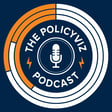
Exploring Creative Data Visualization with Nadieh Bremer
In this episode, I sit down with Nadieh Bremer to talk about her new book, Chart, and the creative process behind her data visualization work. We discuss how she structures the book around a spectrum from straightforward charts to full-on data art, and why uncommon chart types can communicate nuance so effectively. Nadieh shares insights from her time in a makerspace, how physical-making influences her digital work, and why sketching after exploring the data is so important. We also talk about client work, design decisions, and how she thinks about success in her projects. It’s a fun, wide-ranging conversation that highlights why Nadieh remains one of the most thoughtful voices in the field.
Keywords: Nadieh Bremer, data visualization, creative dataviz, data art, uncommon charts, Sankey diagrams, data storytelling, interactive visualization, static visualization, design process, sketching, makerspace, creative charts, PolicyViz Podcast
Subscribe to the PolicyViz Podcast wherever you get your podcasts.
Become a patron of the PolicyViz Podcast for as little as a buck a month
Get Nadieh's latest book, Chart, her previous book Data Sketches, and check out her website, VisualCinnamon.com.
Follow me on Instagram, LinkedIn, Substack, Twitter, Website, YouTube
Email: jon@policyviz.com


